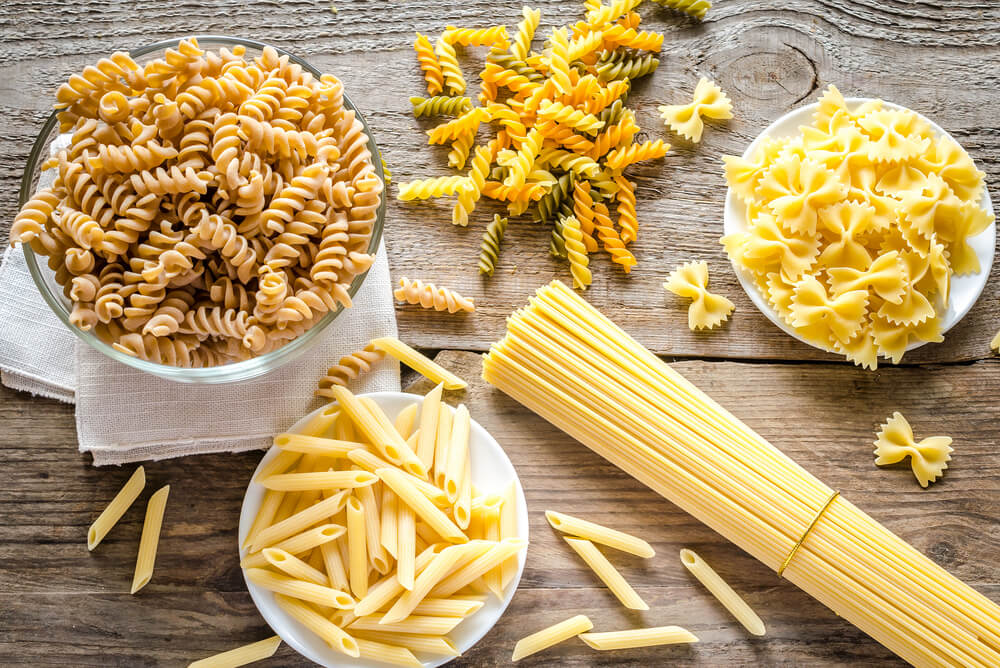Pasta is not just any pasta. Pasta comes in many different shapes, flavors, colors and is made and combined with many different ingredients. Therefore, you can think of pasta as a collective term for Italian dough that needs to be cooked and is often combined with tasty sauces. In this blog we would like to take you to Italy to learn more about all the popular pasta types and shapes.
Pasta shapes
To get an idea of how many different types of pasta there are, we have made an overview with the most popular types, along with a short explanation.
We also give you a suggestion of which sauces and ingredients these types of pasta can be combined with. We make a distinction between long, short and filled pastas!
Long pastas :
Spaghetti
This variant is perhaps the best known among the pasta types. Spaghetti can be used for almost any pasta recipe.
These long, round pasta strands are made in both thin and thicker varieties. Therefore, the name depends on the thickness. So we call very thin spaghetti also spaghettini. A very tasty recipe made with spaghetti is the classic spaghetti carbonara.
Tagliatelle
Pasta strung into ribbon-shaped strips is called tagliatelle. This pasta is often eaten next to spaghetti and is very popular. Tagliatelle can be combined well with light tomato sauces, fish and sauces with a lot of meat.
A tagliatelle is usually about 5mm wide. In our webshop you will only find handmade tagliatelle.
Pappardelle
Pappardelle are just like tagliatelle ribbon-shaped pasta strands. The difference between the two is the width: Pappardelle are a lot wider than tagliatelle, and therefore good to use in combination with hearty beef sauces.
Pappardelle is about 1 cm to 1.5 cm wide. When you use pappardelle for your pasta dish, you create a plate of pasta with a real bite!
Fettuccine
The fettuccine also falls into the family of wide pasta strands. It is the little brother of the tagliatelle. An easy type of pasta which you can use for many pasta recipes. An average fettuccine is about 3mm wide.
Fettuccine are also often used for special pasta variations. You can find our fettuccine with basil, funghi, with eggs or made of spelt wheat. Here is an overview of all our fettuccine.
Linguine
Unlike the fettuccine and pappardelle, the linguine is a narrower variant within the pasta strands family. Because the linguine is often only 2 mm wide, it is a type of pasta that you can use well for light pasta sauces. Here you can find an overview of all our artisanal linguine.
Capellini
Another pasta from the ribbon family is the capellini. This type of pasta is even narrower than the linguine and is often combined with seafood and buttery sauces. Often a cappelini is also called a chitarra.
Fusilli, long
Fusilli is a type of pasta shaped like a spiral. The fusilli is almost always a short type of pasta. A nice variation on the normal short fusilli is the long fusilli. The long fusilli you can combine with many sauces. Want to add some variety to your pasta dishes? Then the long fusilli is definitely worth a try.
Stringhette
Stringhette is a type of pasta that you rarely see. Too bad, because it’s a delicious pasta form that you can actually use for any recipe. Simply put, the stringhette is a square spaghetti.
Short Pastas
Penne
Hollow pasta tubes with slanted ends in a rib jacket are called penne. A well known pasta variant that is often combined with many sauces. Delicious with tomato sauces because the pasta sauce goes into the tubes. This makes your pasta dish even tastier!
Casarecce
This type of pasta is also hollow but not closed. The dough is rolled from the outside in, as it were. Delicious with tomato sauces. Our tip, use the casarecce for a delicious plate of all’arrabiata.
Farfalle
Farfalle are also not to be missed if you are looking for a good base for your Italian dish. Farfalle are butterfly-shaped and can be used for a delicious pasta salad.
Fusilli
As mentioned earlier, fusilli come in long and short varieties. There is no better type of pasta to give your own twist.
Lumache
The lumache pasta has the shape of a snail shell and therefore looks very original. Lumache can be combined with a very thick pasta sauce so that the hollow space of the pasta is filled with sauce. Something that makes your pasta dish even tastier.
Reginette
Reginette pasta is also available in a short and long type of pasta. Reginette are serrated. A fun variation for in your favorite pasta dish.
Tortiglioni
This hollow, straight tube is a nice pasta variety with a slant across it. Think of tortiglioni as a kind of large penne. Definitely recommended for thick tomato sauces.
Rigatoni
Rigationi are short, hollow and round. About the same length as a penne but the diameter of rigatoni is a bit larger. Do you like a pasta with a bite? Then our rigatoni are definitely worth trying.
Pastas to fill:
Canneloni
Canneloni are hollow tubes to fill. For example in a vegetarian jacket with spinach and ricotta, from the oven with a layer of cheese!
Lasagna
Of course you can’t fill the lasagna itself, but you can fill the oven dish! In addition to traditional lasagna, try a variation with pumpkin, pesto or salmon.
Gigantoni
The name says it all: it’s giga! The gigantoni is hollow but flat, short but wide and ribbed. It could be filled just like the canneloni (round lasagna tube).
Conchiglioni
It is shaped like a shell and therefore often filled: the cochiglioni. An extra large shell that provides an extra tasty bite.
Tortellini and ravioli
Tortellini and ravioli are already filled with a delicious filling and can be made by yourself or bought as is. The sauce you combine with it is up to you! You give it a fresh bite when you garnish it with some arugula!
Types of pasta
Pasta does not only differ from each other because of its many shapes: the ingredients used in the dough also differ. Because of this, the color and flavor of the pasta is also different for each type of pasta. We list the differences for you.
Pasta made of durum wheat
The most common type of wheat used in pasta is durum wheat. This wheat is also called durum wheat. This is mainly due to the hard and large grain that durum wheat has.
This makes durum pasta firm and easy to cook. This variant is often light and yellowish in color. View all our pasta types of durum wheat.
Spelt pasta
Spelt, like wheat, comes from the grain family. The difference between the two is the amount of gluten it contains: spelt contains gluten, but less than normal wheat! This means that spelt pasta also contains fewer carbohydrates than durum pasta, for example. In our pasta shop you will find an overview of our spelt pasta.
Whole wheat pasta
The difference between “normal” pasta and wholemeal pasta is the membrane around the wheat grain, which is removed in the “normal” pasta variant and not in the wholemeal variant. This makes the whole wheat pasta more nutritious and darker in color. Whole wheat pasta is also available in a whole wheat spelt variant.
Organic pasta
How the pasta is prepared determines whether it is organic or not. For example, by using wheat varieties that are grown in the wild.
There are no fertilizers or chemicals used by the farmer on this wheat then. It is important to know where the wheat comes from and if the pasta is made in a fair way.
Vegan pasta
Many pasta varieties are made with egg, even though this is often not a necessary ingredient. Pastas that do not contain egg or protein are therefore vegan.
Gluten-free pasta
Gluten-free pastas are made from corn and rice instead of wheat and flour. This makes this pasta variant a little different in taste. However, it is nice that you can still enjoy this delicious Italian dish despite your gluten allergy!
Pasta specials
The pasta specials that Pastafacio offers are made special by an extra ingredient. This often affects the color and taste but not the texture.
Ingredients which can be added to the pasta include: chickpeas, lemon, ginger, funghi, green beans, lentils, truffle, basil, pepperoni or squid. The ingredient included then often determines the color. For example, lentil pasta is orange, squid pasta is black and basil pasta is green.
All in all, there are numerous pasta types, colors and flavors.

